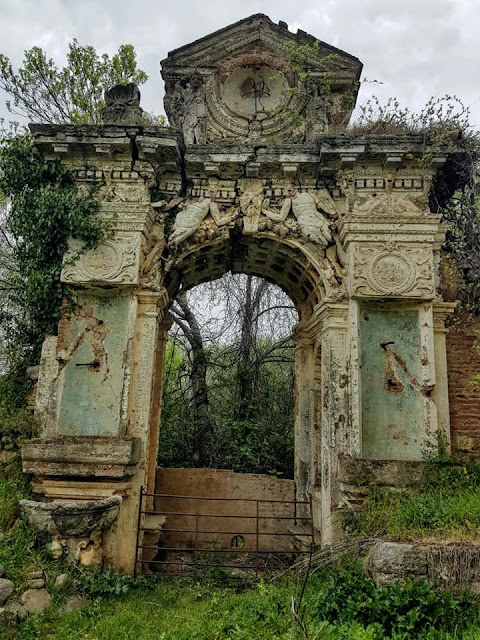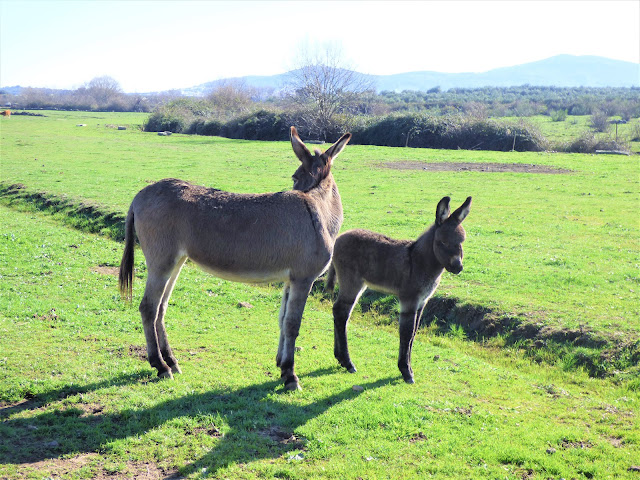Last week we had an invitation for dinner and a stay in La Vera. Very welcome as we can rarely get away from the finca in the Summer when we have all our lovely guests staying but we thought we could risk one night away, I am so happy we went, it was most delightful.
A fast journey through Trujillo, up the motorway and then branching off through lush tobacco fields on the lower slopes of the Gredos with the impressive silhouette of the highest peak, Pico Almanzor looming in the distance. How many villages are there with La Vera in their name? Very many but finally we came to Villanueva de la Vera our meeting point with Cristóbal at his Baraka Café, a local Muslim community project, not only running the café and restaurant but also hosting film and musical events with occasional conferences and lectures, also a regular Sunday morning farmers' market on the patio.
http://www.barakadelavera.com/
It was very hot despite being in the mountains but there is water everywhere edged with verdant ferns and undergrowth. We followed a dusty camino along the side one of the many river gargantas (gorges) of the sierra, deep into the mountains. Thankfully we knew there was going to be a lovely cool swim in a natural swimming pool worn out of the rocks by the mountain stream.
First we dropped our things off at the stone house where we would be staying, how charming it looked set in its GREEN lawn, everything was GREEN, a wonder for us coming from our golden Summer landscape further South.
(It was certainly a great experience to wake up the following day with early morning sunlight filtering through the trees, enjoying breakfast on the beautiful balcony, all the ironwork is designed and made by Cristóbal using a laser cutting technique.)
We continued further up the track to Alicia and Cristóbal's house set in more greenery with stupendous views of rolling hills and up to dramatic mountain scenery, a lovely family home that has grown from an original stone farmhouse.
After greeting Alicia and some other guests we almost ran down the winding steep slope to the river below and the enticing clear cool water. What bliss! I swam in one place against the strong current, delicious, but Manfred couldn't resist the natural stone chute which propelled him rather swiftly from one pool to the next.
More people arrived and there was much conviviality, good food and wine under pristine stars of the sierra. Much later, back to the comfort of our little house in the woods and a good sleep.
Before getting back to our Summer duties at Finca al-manzil we went up to say goodbye and see the wonders of the stone circle, sculpture garden and of course Cristóbal's studio .
Cristóbal is a sculptor, mainly using the lost wax technique for bronze sculptures but also works in stone, wood and iron, his studio is a treasure house of stunning objects arranged in seemingly haphazard groups which exude an exotically precious aura.
Nature is an obvious inspiration; goats, dogs, lions, toads, whales,chameleons, armadillos and dragonflies are scattered in profusion as well as simple organic shapes. My favourite piece was a group of three beautiful objects vaguely like giant sharks teeth, all bronze but with different treatments giving three different textures and tones but all the same shape. Bronze books open to pages of Adam and Eve; Arabic calligraphy and geometric designs are a favourite theme. You can see more here
www.cristobalsculpt.com
Just before we departed we walked a little way up the hill, past the sculpture garden, past the stables and the small meadow set up for archery practise on horseback, a little further and we came to a plateau with an extensive stone circle, the stones were not very massive but had apparently been placed with due ceremony and appropriate chantings by a Hopi Indian on a visit from America, according to him the place had a very strong spiritual force. This is not uncommon in the mountains where ancient people made their refuges.
Time to say goodbye to this magic place with promises to get together again in the Autumn.
On our way home we stopped at the Monastery of Yuste which is very close.
http://www.spain.info/en/conoce/monumentos/caceres/monasterio_de_yuste.html
Once again I was impressed by the wonderfully peaceful situation, buried in deepest woods. In the 16th century a remote and inaccessible place chosen by the Holy Roman Emperor Charles V to retire from his vast empire, the most powerful ruler on earth lived his last years in relative simplicity still plagued by chronic gout.
The special chair for supporting his gouty foot is on exhibition as well as the incredibly small bed positioned so he could hear mass through a door looking on to the high altar, this room is hung with deepest black velvet curtains, the originals described by a visitor before the Emperor's death in 1558.
We arrived home to the finca to find that all was well, everyone happy........so we look forward to our next quick little getaway.
In the meantime here is an extract from one of Federico García Lorca's most beautiful collection of ballads, Romancero Gitano, it reminds me of La Vera, green and mysterious.
This is a fragment from the ballad Romance Sonámbulo
http://usuaris.tinet.cat/picl/libros/glorca/gl002500.htm#04
Verde que te quiero
verde.
Verde viento. Verdes ramas.
El barco sobre la mar
y el
caballo en la montaña.
Con la sombra en la cintura
ella sueña en su
baranda
verde carne, pelo verde,
con ojos de fría plata.
Verde que
te quiero verde.
Bajo la luna gitana,
las cosas la están mirando
y
ella no puede mirarlas.
Verde que te quiero verde.
Grandes estrellas
de escarcha,
vienen con el pez de sombra
que abre el camino del alba.
La higuera frota su viento
con la lija de sus ramas,
y el monte,
gato garduño,
eriza sus pitas agrias.
¿Pero quién vendrá? ¿Y por
dónde...?
Ella sigue en su baranda,
verde carne, pelo verde,
soñando
en la mar amarga.















































